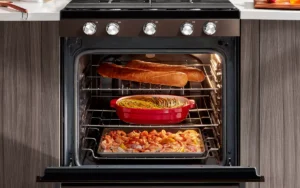Microwaves are a kitchen staple for a reason—they’re quick, convenient, and can handle everything from reheating leftovers to cooking a full meal. But while microwaves are incredibly user-friendly, it’s important to know the dos and don’ts to ensure you’re cooking safely and efficiently. Let’s dive into some essential tips for making the most of your microwave, all while keeping your kitchen mishap-free.
Do Use Microwave-Safe Containers
One of the most important rules for microwave cooking is to use containers that are specifically labeled as microwave-safe. Glass, ceramic, and certain plastics are typically safe options. However, not all plastics are created equal—some can melt or leach harmful chemicals into your food when heated. Avoid using old, cracked, or scratched plastic containers, as they can be especially prone to these issues. When in doubt, check the bottom of the container for a microwave-safe label.
Don’t Use Metal or Foil
It’s tempting to throw any dish into the microwave without thinking twice, but when it comes to metal, you need to be cautious. Metal reflects microwaves, causing sparks and potentially damaging your appliance or starting a fire. The same goes for aluminum foil. While small amounts might be okay for shielding parts of food that could overcook, it’s generally safer to avoid foil altogether. Stick to microwave-safe materials to keep things safe and sound.
Do Stir and Rotate Your Food
Microwaves cook by heating food from the outside in, which can sometimes lead to uneven cooking. To ensure your food heats evenly, stir it halfway through the cooking process. If your microwave doesn’t have a turntable, rotate the dish manually to prevent cold spots. This is especially important for dense foods like casseroles or soups, where the center might remain cool while the edges are piping hot.
Don’t Overcook Your Food
Microwaves cook food quickly, so it’s easy to overdo it if you’re not careful. Overcooking can lead to dry, tough food that’s far from appetizing. It can also cause certain foods to splatter, making a mess inside your microwave. To avoid this, start with the minimum recommended cooking time and check your food periodically. You can always add more time if needed, but you can’t undo overcooking.
Do Cover Your Food
Covering your food while it cooks in the microwave is a great way to prevent splatters and retain moisture. Use a microwave-safe lid, a paper towel, or even a microwave-safe plate to cover your dish. Just be sure to leave a small vent to allow steam to escape, which prevents pressure from building up and causing the cover to pop off. This simple step keeps your microwave cleaner and your food juicier.
Don’t Microwave Eggs in the Shell
If you’ve ever tried microwaving an egg in its shell, you probably know it doesn’t end well. The steam inside the egg builds up rapidly, causing it to explode—leaving you with a mess and potentially even a burnt hand. To cook eggs safely in the microwave, always remove them from the shell first. Scrambled eggs, poached eggs, and even omelets can be made quickly and easily in the microwave, as long as you take this crucial step.
Do Reheat Leftovers Properly
Reheating leftovers in the microwave is a breeze, but it’s important to do it safely to avoid foodborne illnesses. Make sure leftovers are heated to an internal temperature of at least 165°F to kill any harmful bacteria. Stirring the food midway through reheating helps ensure even heating. When reheating liquids, like soups or sauces, be careful to avoid superheating—this occurs when the liquid is heated beyond its boiling point without actually boiling, leading to a sudden and dangerous eruption when disturbed.
Don’t Use the Microwave as a Storage Spot
It might be tempting to use your microwave as an extra storage space for plates, food containers, or even small appliances, but resist the urge. Not only does this clutter your microwave, but it also poses a safety risk. Accidentally turning on the microwave with items inside that aren’t meant to be microwaved can lead to fires or damage to your appliance. Keep your microwave clear and ready for its intended use—cooking and reheating food.
Do Be Mindful of Cooking Times for Different Foods
Different foods require different cooking times, and microwaves don’t always distribute heat evenly. For example, foods with high water content, like vegetables, cook faster than dense, starchy foods like potatoes. To avoid overcooking or undercooking, adjust cooking times based on the type of food you’re preparing. Consider cutting larger pieces of food into smaller, uniform sizes to promote even cooking.
Don’t Ignore Strange Odors or Noises
If you notice any unusual smells, sounds, or sparking while your microwave is in use, stop it immediately and investigate. Strange odors can indicate burning food or plastic, while odd noises or sparks might suggest an issue with the microwave itself. Continuing to use a malfunctioning microwave can be dangerous, so it’s better to err on the side of caution. If you’re unsure what’s causing the issue, consult the user manual or contact a professional for advice.
Do Keep Your Microwave Clean
Regular cleaning is essential to keep your microwave functioning properly and safely. Food splatters can absorb microwave energy, leading to burnt spots and reducing the efficiency of your appliance. Wipe down the interior with a damp cloth and mild detergent after each use. For stubborn stains or odors, heat a bowl of water with lemon slices or vinegar for a few minutes, then wipe clean. This not only keeps your microwave in tip-top shape but also helps prevent cross-contamination of flavors between different foods.
Conclusion: Cook Safely and Smartly
Your microwave is a powerful tool in the kitchen, and when used correctly, it can make meal prep a breeze. By following these dos and don’ts, you’ll ensure safe, efficient, and delicious results every time you use it. From using the right containers to covering your food and keeping your microwave clean, these simple tips can make a big difference. So go ahead, embrace the convenience of your microwave, and cook with confidence! Happy microwaving!









